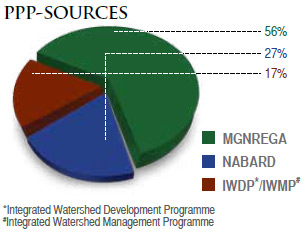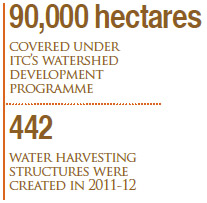ITC Limited
Sustainability Report 2012
Social Performance
Social Investments - Mission Sunhera Kal
Soil and Moisture Conservation
The Soil and Moisture Conservation Programme, designed to assist farmers in identified moisture-stressed districts, currently covers nearly 90,000 hectares
 The Soil and Moisture Conservation Programme, designed to assist farmers in identified moisture-stressed districts, increased by another 24,992 hectares. 442 water harvesting structures were created during the year 2011-12. Currently the total area covered under the watershed programme cumulatively stands at 89,491 hectares.
The Soil and Moisture Conservation Programme, designed to assist farmers in identified moisture-stressed districts, increased by another 24,992 hectares. 442 water harvesting structures were created during the year 2011-12. Currently the total area covered under the watershed programme cumulatively stands at 89,491 hectares.
Our project in Sehore (Madhya Pradesh) was at the vanguard of a welcome and encouraging development. It was included in the list of 47 best sites by the Rajiv Gandhi Mission for Watershed Management, Government of Madhya Pradesh, for exposure visits by all concerned government staff of the IWMP projects being implemented by the government.
Most of the watershed programmes are now being implemented in partnership either with NABARD or various state governments. Some of the highlights of the partnership programmes include:
 |
Two new MoUs were signed with the Government of Rajasthan for promoting sustainable livelihoods through watershed development in the districts of Bundi and Pratapgarh under MGNREGA. It has been planned to treat 10,000 hectares for soil moisture conservation over a period of 5 years. With this, the total area for watershed development under the PPP projects now stands at 1.23 lakh hectares. |
 |
 |
Work on the PPP projects with the state governments has been progressing well. By the close of the financial year, the PPP projects cumulatively covered nearly 14,000 hectares (18% of the 5 year target) in the three states where government programmes are being implemented. |
|
 |
Under the NABARD partnership projects, more than 12,000 hectares have been covered to date, forming 36% of the total target. |
|
 |
Conforming to the priority of creating capacities of the PRIs, training programmes were organised for Gram Panchayat members, Gramsevaks and VDC members. These were done in the project districts of Maharashtra on MGNREGS, Panchayati Raj Institutions, and the roles and responsibilities of different stakeholders. |